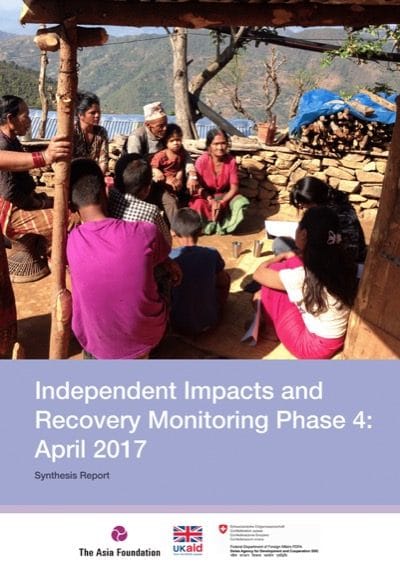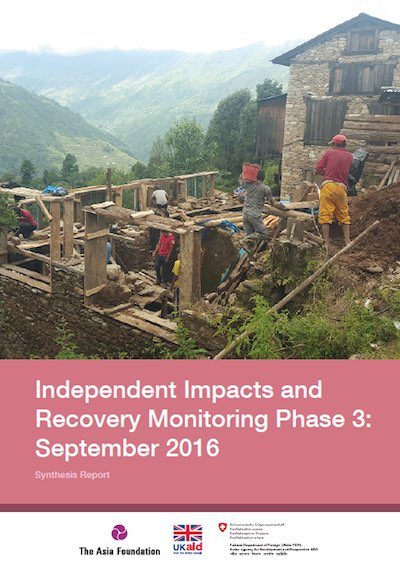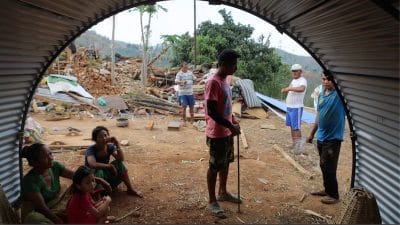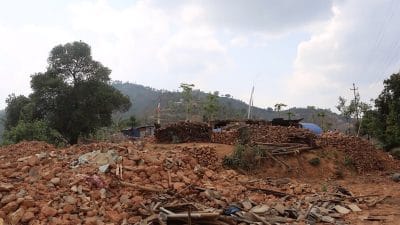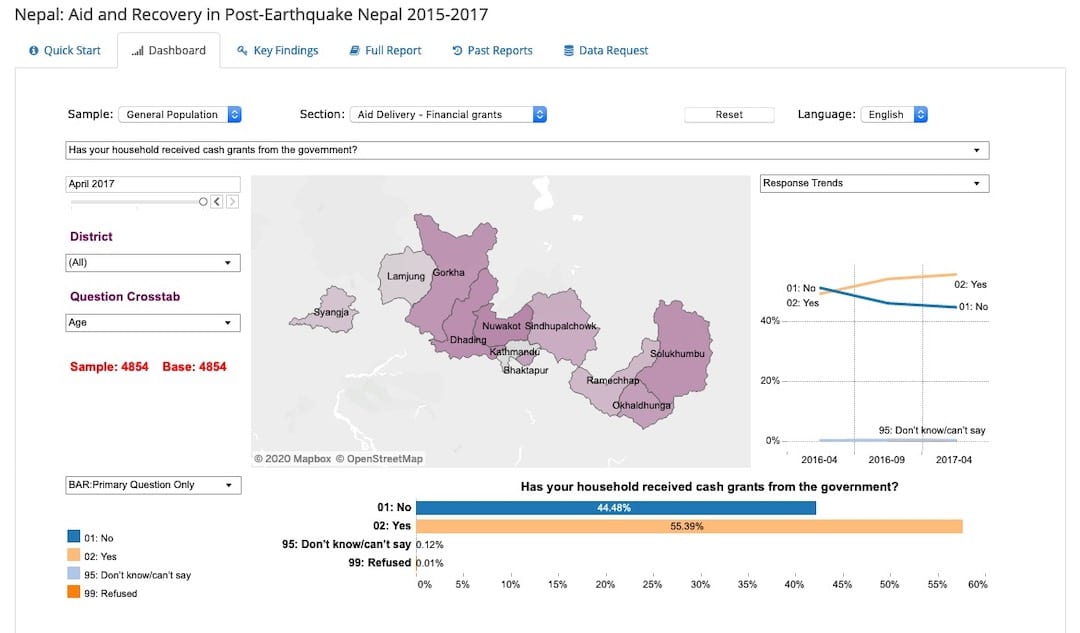Independent Impacts and Recovery Monitoring Nepal
(IRM Project)
The independent Impacts and Recovery Monitoring Project (IRM) was implemented almost immediately after a devastating earthquake hit Nepal on 25 April 2015, followed by another major quake on 12 May 2015. IRM is a longitudinal mixed-methods study developed to systematically monitor patterns of recovery and evolving needs, to track whether disaster responses were effective and accountable. The first round of research took place in June 2015, with three subsequent rounds until April 2017, and another round in 2019 leading up to the five year anniversary of the earthquake. The data help present a clearer picture of who is recovering, who is not, and what are the reasons.
Project overview
 Phase 5
Phase 5
November 2019
This report shares findings and analysis from the fifth round of qualitative monitoring conducted in November 2019, in four earthquake-affected districts. The findings presented in this report focus on housing recovery after the April-May 2015 earthquakes in Nepal. This research observed much progress in reconstruction, with many new houses rebuilt, while progress in retrofitting remained slow.
Phase 4
April 2017
Two years after two powerful earthquakes hit Nepal in April and May 2015, the Independent Impacts and Recovery Monitoring project (IRM) completed its fourth round of research to track how people are recovering, what aid has been provided and how effective it has been, which groups are being left behind, and what coping strategies people have used.
Phase 3
September 2016
Eighteen months from the earthquakes that hit Nepal in April and May 2015, the third wave of the Independent Impacts and Recovery Monitoring project (IRM) tracks the extent to which people have recovered, what coping strategies they are using and how effective they are, how aid is helping and which groups are being left behind.
Thematic Report
Nepal Government Distribution of Earthquake Reconstruction Cash Grants for Private Houses
This report details findings from the qualitative field research conducted in Gorkha and Dolakha—the first two districts where the disbursement started—during July 2016 along with data from three rounds of qualitative and quantitative fieldwork.
Phase 2
February-March 2016
One year on from 25 April 2015, when a devastating earthquake hit Nepal, the situation in affected areas reveals the depth of impacts and the complex ways in which recovery is occurring. The second wave of the Independent Impacts and Recovery Monitoring (IRM), conducted in March 2016, tracks changes since last June.
Phase 1
June 2015
On 25 April 2015, a powerful 7.8-magnitude earthquake struck Nepal. Thousands were killed, tens of thousands were injured, and hundreds of thousands of homes were damaged or destroyed. A second major earthquake struck less than three weeks later, killing hundreds more and adding to the destruction.
Independent Impacts and Recovery Monitoring (IRM) Project Nepal Overview
Publication
Learn about the Independent Impacts and Recovery Monitoring Project (IRM).
Independent Impacts and Recovery Monitoring (IRM) Project Nepal – Early Findings from Round 5
March 16, 2020
Publication
The Independent Impacts and Recovery Monitoring Project (IRM) was implemented almost immediately after two devastating earthquakes hit Nepal on 25 April 2015 and 12 May 2015. IRM is a longitudinal mixed-methods study developed to systematically monitor social impacts of the disaster and the response over the longer-term, collecting evidence that goes beyond one-off damage and needs assessments. This briefing note…
Dalits Left Behind as Nepal Slowly Recovers
April 19, 2017
Blog Post
Two years ago, Nepal was hit by two devastating earthquakes. As the country still struggles to recover, evidence from research conducted by The Asia Foundation reveals that Dalits, a section of society traditionally deemed as “untouchable,” and other lower caste groups face particular barriers which have made recovery more challenging. Natural disa… Read more
Asia Foundation Releases New Report on Aid and Recovery in Post-Earthquake Nepal
Kathmandu, March 15, 2017
News Post
Eighteen months from the earthquakes that hit Nepal in April and May 2015, The Asia Foundation is releasing the first report in the third wave of the Independent Impacts and Recovery Monitoring project (IRM). The project assesses the extent to which people have recovered, what coping strategies they are using and how effective they are, how aid is… Read more
Aid and Recovery in Post‐Earthquake Nepal: Eighteen Months On
December 27, 2016
Publication
Early findings from Independent Impacts and Recovery Monitoring Round Three One and a half years after the devastating earthquakes in Nepal, how have conditions in the affected zone evolved? This brief provides preliminary findings from the third round of the Foundation’s longitudinal mixed method research, Independent Impacts and Recovery Monitori… Read more
Nepal Government Distribution of Earthquake Reconstruction Cash Grants for Private Houses
December 14, 2016
Publication
The earthquakes of April and May 2015 caused massive housing destruction with over half a million houses collapsed or badly damaged. Over 18 months on from the earthquakes, the pace of reconstruction has been slow. Most people whose homes were damaged remained in self-constructed temporary shelters or had moved back into their dangerously damaged h… Read more
4 Things to Know About Post-Earthquake Aid and Recovery in Nepal
October 5, 2016
Blog Post
A year and a half after a series of major earthquakes struck Nepal, causing widespread devastation and killing nearly 9,000 people, the pace of reconstruction remains painfully slow. One month ago, the prime minister announced an additional $1,000 in relief per household, which would raise the total resources available to each affected household to… Read more
Asia Foundation Releases Report on Aid and Recovery in Post-Earthquake Nepal
Kathmandu, September 26, 2016
News Post
Following the deadly earthquakes in Nepal last year, The Asia Foundation developed the Independent Impacts and Recovery Monitoring (IRM) project, which tracks the effectiveness of aid delivery and its impact on recovery in the aftermath of the earthquakes. Recently, the Foundation released the second phase of reports, which focuses on the depth of… Read more
Tracking Conditions on the Ground in Post-Earthquake Nepal
June 1, 2016
Blog Post
The impacts of the devastating earthquakes that struck Nepal in April and May of 2015 are still being felt by thousands of families in affected districts. It has been, and will continue to be, a significant challenge for Nepal to fully recover. In order to plan and implement effective responses, up-to-date and accurate information from the field wi… Read more
Aid and Recovery in Post-Earthquake Nepal: One Year On
May 21, 2016
Publication
The devastating earthquake that struck Nepal on 25 April 2015 impacted hundreds of thousands of lives. High quality information from affected areas is critical to planning and delivering recovery and reconstruction assistance. The Independent Impacts and Recovery Monitoring for Accountability in Post-Earthquake Nepal (IRM) project provides regular… Read more
Independent Impacts and Recovery Monitoring Project

Interview: Singh Bahadur Khatri (Kerabari, Sindhupalchok)
Interview: Setimaya Damai (Syaule, Sindhupalchok)
Interview: Junimaya Tamang (Katarje, Sindhupalchok)
Aid and Recovery in Post-Earthquake Nepal – Part 2

Aid and Recovery in Post-Earthquake Nepal
The Independent Impacts and Recovery Monitoring for Accountability in Post-Earthquake Nepal (IRM) project provides regular and rigorous data on how people’s needs are evolving, the challenges they face, the coping strategies they use, and the extent to which aid is helping. This video features interviews with affected households and was produced by… Read more

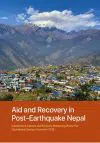 Phase 5
Phase 5